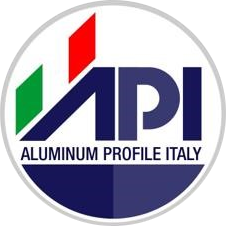The aluminum extrusion
The aluminum extrusion process essentially consists of forcing the material (aluminium alloy), in its pasty state, by compression, to pass through a shape ("matrix" or "die") which reproduces the external shape of the piece you want to obtain .
which reproduces the external shape of the piece you want to obtain .
The matrices are the shapes in which the aluminum billets (raw material in the form of solid cylinders), suitably preheated, are pushed under pressure and transformed - with a process called extrusion - into long shaped bars.
In the aluminum extrusion process, the raw material used is called billet and comes in the form of logs (cylinders with a diameter of 10" and lengths varying from 5 to 7 m).

To reach the pasty state necessary to guarantee the deformability of the material, the billets are heated in a special oven at a temperature of approximately 450°-500°C (depending on the alloy used) and subsequently conveyed into the press by passing over a slide.
The press has the function of compressing the material made "mushy" by the appropriate previous heating in the oven, forcibly conveying it with adequate pressure and "forcing" it to pass through the matrix to obtain the desired shape and therefore the desired profile.
Upon exiting the die, the profile, which is devoid of rigidity, undergoes a first cooling phase using appropriate fans.

It is then grabbed by a device called a "puller" which works like a vice and which, grabbing the profile, forcibly drags it out of the press, placing it on the roller conveyor where, still in a "flexible" state, it undergoes further cooling thanks to a air positioned in the carpentry of the same roller conveyor.





